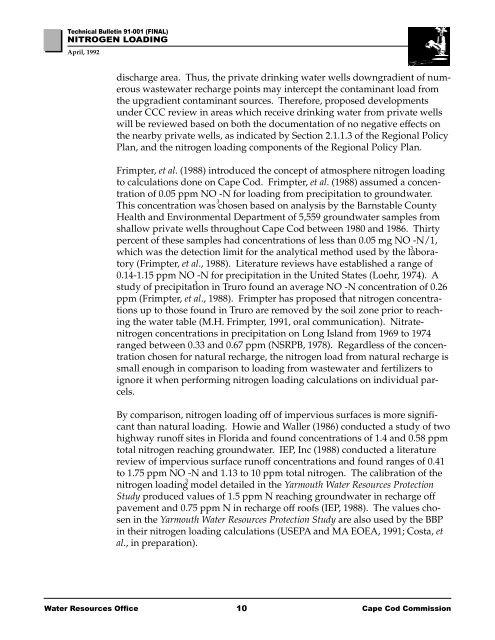Technical Bulletin 91-001 Nitrogen Loading - Cape Cod Commission
Technical Bulletin 91-001 Nitrogen Loading - Cape Cod Commission
Technical Bulletin 91-001 Nitrogen Loading - Cape Cod Commission
You also want an ePaper? Increase the reach of your titles
YUMPU automatically turns print PDFs into web optimized ePapers that Google loves.
<strong>Technical</strong> <strong>Bulletin</strong> <strong>91</strong>-<strong>001</strong> (FINAL)<br />
NITROGEN LOADING<br />
April, 1992<br />
discharge area. Thus, the private drinking water wells downgradient of numerous<br />
wastewater recharge points may intercept the contaminant load from<br />
the upgradient contaminant sources. Therefore, proposed developments<br />
under CCC review in areas which receive drinking water from private wells<br />
will be reviewed based on both the documentation of no negative effects on<br />
the nearby private wells, as indicated by Section 2.1.1.3 of the Regional Policy<br />
Plan, and the nitrogen loading components of the Regional Policy Plan.<br />
Frimpter, et al. (1988) introduced the concept of atmosphere nitrogen loading<br />
to calculations done on <strong>Cape</strong> <strong>Cod</strong>. Frimpter, et al. (1988) assumed a concentration<br />
of 0.05 ppm NO -N for loading from precipitation to groundwater.<br />
3<br />
This concentration was chosen based on analysis by the Barnstable County<br />
Health and Environmental Department of 5,559 groundwater samples from<br />
shallow private wells throughout <strong>Cape</strong> <strong>Cod</strong> between 1980 and 1986. Thirty<br />
percent of these samples had concentrations of less than 0.05 mg NO -N/1,<br />
3<br />
which was the detection limit for the analytical method used by the laboratory<br />
(Frimpter, et al., 1988). Literature reviews have established a range of<br />
0.14-1.15 ppm NO -N for precipitation in the United States (Loehr, 1974). A<br />
3<br />
study of precipitation in Truro found an average NO -N concentration of 0.26<br />
3<br />
ppm (Frimpter, et al., 1988). Frimpter has proposed that nitrogen concentrations<br />
up to those found in Truro are removed by the soil zone prior to reaching<br />
the water table (M.H. Frimpter, 19<strong>91</strong>, oral communication). Nitratenitrogen<br />
concentrations in precipitation on Long Island from 1969 to 1974<br />
ranged between 0.33 and 0.67 ppm (NSRPB, 1978). Regardless of the concentration<br />
chosen for natural recharge, the nitrogen load from natural recharge is<br />
small enough in comparison to loading from wastewater and fertilizers to<br />
ignore it when performing nitrogen loading calculations on individual parcels.<br />
By comparison, nitrogen loading off of impervious surfaces is more significant<br />
than natural loading. Howie and Waller (1986) conducted a study of two<br />
highway runoff sites in Florida and found concentrations of 1.4 and 0.58 ppm<br />
total nitrogen reaching groundwater. IEP, Inc (1988) conducted a literature<br />
review of impervious surface runoff concentrations and found ranges of 0.41<br />
to 1.75 ppm NO -N and 1.13 to 10 ppm total nitrogen. The calibration of the<br />
3<br />
nitrogen loading model detailed in the Yarmouth Water Resources Protection<br />
Study produced values of 1.5 ppm N reaching groundwater in recharge off<br />
pavement and 0.75 ppm N in recharge off roofs (IEP, 1988). The values chosen<br />
in the Yarmouth Water Resources Protection Study are also used by the BBP<br />
in their nitrogen loading calculations (USEPA and MA EOEA, 19<strong>91</strong>; Costa, et<br />
al., in preparation).<br />
Water Resources Office 10<br />
<strong>Cape</strong> <strong>Cod</strong> <strong>Commission</strong>
















